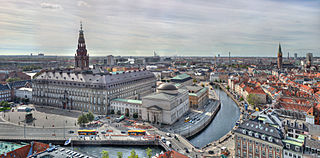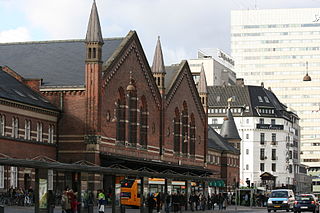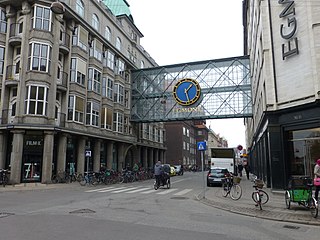
Copenhagen is the capital and most populous city of Denmark, with a population of 1.4 million in the urban area. The city is situated on the islands of Zealand and Amager, separated from Malmö, Sweden, by the Øresund strait. The Øresund Bridge connects the two cities by rail and road.

The Copenhagen Metro is a light rapid transit system in Copenhagen, Denmark, serving the municipalities of Copenhagen, Frederiksberg, and Tårnby.

Mikael Colville-Andersen is a Canadian-Danish urban designer and urban mobility expert. He was the CEO of Copenhagenize Design Company, which he founded in 2009 in Copenhagen, and he works with cities and governments around the world in coaching them towards becoming more bicycle-friendly. He is the host of the urbanism documentary television series The Life-Sized City, which premiered in 2017 on TVOntario and in 2018 on various other international channels including Finland's national broadcaster YLE and Italian broadcaster La Effe. Season 1 of The Life-Sized City was nominated for five Canadian Screen Awards in 2018.

Strøget is a pedestrian, car-free shopping area in Copenhagen, Denmark. This popular tourist attraction in the centre of town is one of the longest pedestrian shopping streets in Europe at 1.1 km. Located at the centre of the old city of Copenhagen, it has long been one of the most high-profile streets in the city.

The history of Copenhagen dates back to the first settlement at the site in the 11th century. From the middle of the 12th century it grew in importance after coming into the possession of Bishop Absalon, and the city was fortified with a stone wall during the 13th century. The harbour and the excellent possibilities for herring fishing contributed to Copenhagen's growth and development into an important trading centre. It was repeatedly attacked by the Hanseatic League as the Germans became aware of its expansion. In 1254, it received its charter as a city under Bishop Jakob Erlandsen.

The urban area of Copenhagen, lying mostly in the Capital Region of Denmark but also in Region Zealand, consist of Copenhagen and Frederiksberg municipalities and the former Copenhagen County. In all, it consists of 18 municipalities, and except parts of Ballerup, Greve, Ishøj, former Søllerød and former Værløse, mentioned with their population included from 2007. Ishøj and Greve Strand are included for the first time since 1999. As of 1 January 2024, this area had a population of 1,378,649. Statistics Denmark states that the definition of the urban area is based on UN's 200m definition.

Copenhagen Central Station is the main railway station in Copenhagen, Denmark, and the largest railway station in Denmark. With more than 100,000 travellers every day, it is the second busiest station in Denmark after Nørreport station. It is located in central Copenhagen, situated between the districts of Indre By and Vesterbro with entrances from Bernstorffsgade, Banegårdspladsen, Reventlowsgade and access to platforms from Tietgensgade.

Vesterbro is one of the 15 administrative, statistical, and city tax districts (bydele) comprising the municipality of Copenhagen, Denmark. It covers an area of 3.76 km2 (1.45 sq mi), and has a population of 51,466 and a population density of 13,688 per km2.

Vanløse is one of the 10 official districts of Copenhagen Municipality, Denmark. It lies on the western border of the municipality. Vanløse covers an area of 6.69 km2, and has a population of 36,115, making Vanløse the smallest district of Copenhagen, by population.

Cycle chic or bicycle chic refers to cycling in fashionable everyday clothes. The fashion concept developed in popular culture to include bicycles and bicycle accessories as well as clothing. The phrase Cycle Chic was coined in 2007 by Mikael Colville-Andersen, who started the Copenhagen Cycle Chic blog in the same year.

The German invasion of Denmark, was the German attack on Denmark on 9 April 1940, during the Second World War. The attack was a prelude to the invasion of Norway.

Cycling in Copenhagen is – as with most cycling in Denmark – an important mode of transportation and a dominating feature of the cityscape, often noticed by visitors. The city offers a variety of favourable cycling conditions — dense urban proximities, short distances and flat terrain — along with an extensive and well-designed system of cycle tracks. This has earned it a reputation as one of the most bicycle-friendly cities in the world. Every day 1.2 million kilometres are cycled in Copenhagen, with 62% of all citizens commuting to work, school, or university by bicycle; in fact, almost as many people commute by bicycle in greater Copenhagen as do those cycle to work in the entire United States. Cycling is generally perceived as a healthier, more environmentally friendly, cheaper, and often quicker way to get around town than by using an automobile.

Copenhagen City Bikes or Bycykler København was the bicycle sharing system of Copenhagen, Denmark. Launched in 1995 with 1,000 cycles, the project was the world's first organized large-scale urban bike-sharing scheme, which, unlike its Dutch predecessor, featured what are now considered basic elements such as coin deposit, fixed stands and specially designed bikes with parts that cannot be used on other bikes. Riders paid a refundable deposit at one of 110 special bike stands and had unlimited use of a bike within the specified downtown area. The scheme was funded by commercial sponsors. In return, the bikes carried advertisements, which appeared on the bike frame and the solid-disk type wheels. When the programme was abolished in October 2012, some 1,500–1,700 bikes were still in service, out of a total of 2,500 put onto the streets.
Events from the year 1807 in Denmark.

Copenhagenization is an expression which was coined in the early nineteenth century, and has seen occasional use since. The expression refers to a decisive blow delivered to a foreign navy while it is still anchored at port in its home nation. It originated from the Royal Navy's bombardment of Copenhagen in 1807, during the Napoleonic Wars. The term is not recorded in either the Merriam-Webster or the Oxford English dictionaries.

Cycling in Denmark is both a common and popular recreational and utilitarian activity. Bicycling infrastructure is a dominant feature of both city and countryside infrastructure with segregated dedicated bicycle paths and lanes in many places and the network of 11 Danish National Cycle Routes extends more than 12,000 kilometres (7,500 mi) nationwide. Often bicycling and bicycle culture in Denmark is compared to the Netherlands as a bicycle-nation.
Transport in Copenhagen and the surrounding area relies on a well-established infrastructure making it a hub in Northern Europe due to its road and rail networks as well as its international airport. Thanks to its many cycle tracks, Copenhagen is considered one of the world's most bicycle-friendly cities. The metro and S-train systems are key features of the city's well-developed public transport facilities. Since July 2000, the Øresund Bridge has served as a road and rail link to Malmö in Sweden. The city is also served by ferry connections to Oslo in Norway while its award-winning harbour is an ever more popular port of call for cruise ships.

Åboulevard is a street in central Copenhagen, Denmark. Together with H. C. Andersens Boulevard in the city centre and Borups Allé, it forms a major artery in and out of the city. The road is built over Ladegårds Å, a canal originally built to supply Copenhagen with water, which still runs in a pipe under it, feeding water into Peblinge Lake.

Vognmagergade is a street located one block south of Rosenborg Castle Gardens in the Old Town of Copenhagen, Denmark. The street runs from Møntergade in the southeast to Landemærket in the northwest, linking Gammel Mønt with Åbenrå. All the buildings in the street date from the years after an urban renewal project in the 1910s. A dominating feature is a glazed skyway with a clockl and the name Egmont. Københavns VUC, an adult education centre, is based at No. 8.
















